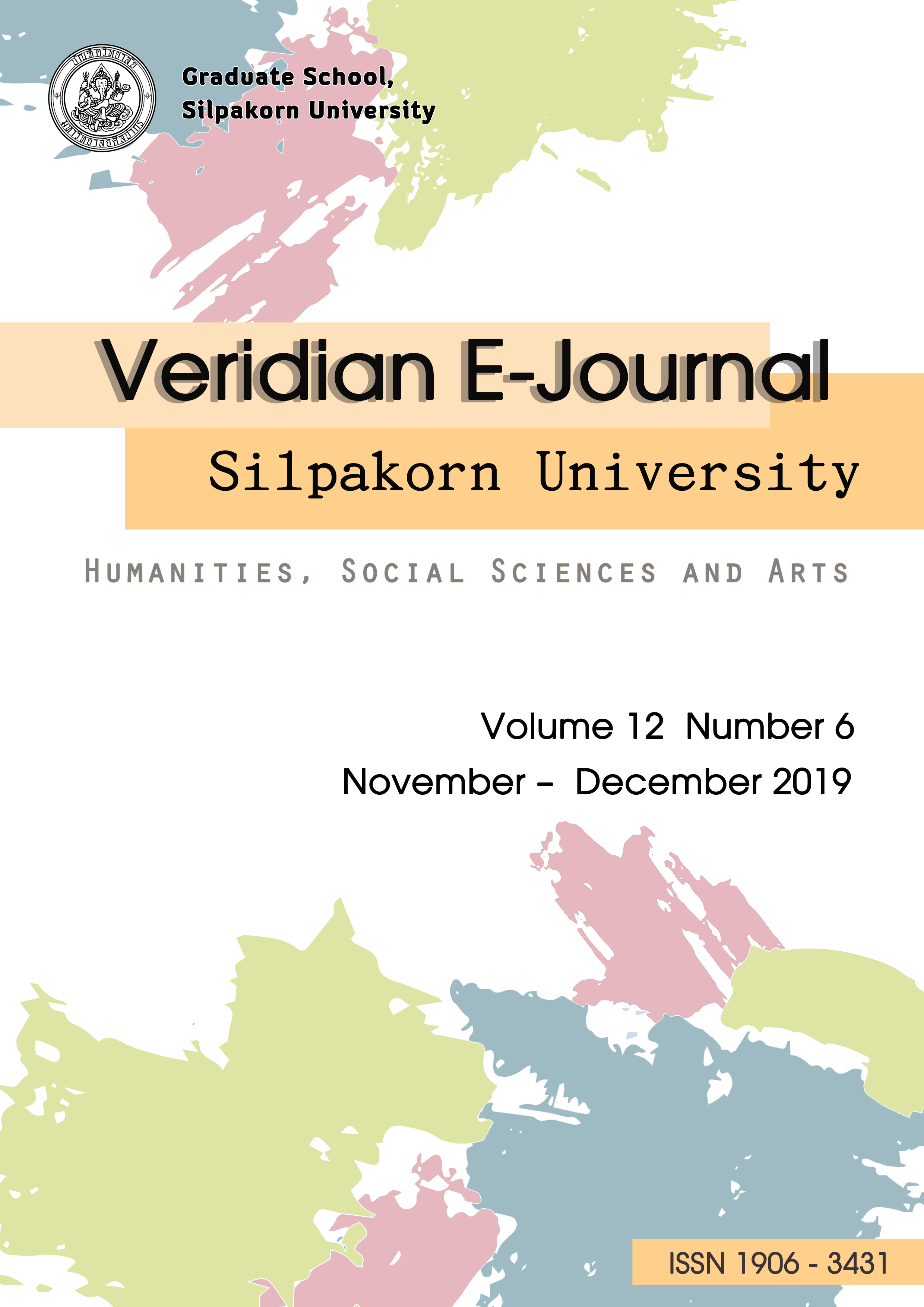การจัดการความเสี่ยงจากภัยพิบัติทางธรรมชาติของจังหวัดชัยนาท (National Disaster Risk Management in Chainat Province)
Main Article Content
บทคัดย่อ
การวิจัยครั้งนี้มีวัตถุประสงค์เพื่อ1.วิเคราะห์ความเสี่ยงจากภัยพิบัติทางธรรมชาติในจังหวัดชัยนาท 2.เพื่อศึกษาการจัดการความเสี่ยงจากภัยพิบัติทางธรรมชาติในจังหวัดชัยนาท3.เพื่อนำเสนอแนวทางส่งเสริมความร่วมมือระหว่างภาครัฐ ภาคประชาชนและภาคเอกชนในการจัดการความเสี่ยงจากภัยพิบัติทางธรรมชาติในจังหวัดชัยนาท การวิจัยครั้งนี้เป็นการวิจัยเชิงคุณภาพ (Qualitative Research) มุ่งศึกษาการวิเคราะห์ความเสี่ยงและการจัดการความเสี่ยงจากภัยพิบัติ ทางธรรมชาติของจังหวัดชัยนาท รวมถึงนำเสนอแนวทางการส่งเสริมความร่วมมือระหว่างภาครัฐ ภาคประชาชน และภาคเอกชนในการจัดการความเสี่ยงจากภัยพิบัติทางธรรมชาติของจังหวัดชัยนาท โดยใช้การสังเกตการณ์แบบมีส่วนร่วมและไม่มีส่วนร่วม (Participation Observation and Non-Participation Observation) และการสัมภาษณ์เชิงลึก (in-depth interview) จากผู้ให้ข้อมูลสำคัญ (key informant) ซึ่งเป็นตัวแทนของภาครัฐ ภาคประชาชน และภาคเอกชน จำนวน 24 คน รวมถึงการสนทนากลุ่ม (focus group) และสานเสวนา (Dialogue) โดยมีผู้เข้าร่วมสานเสวนาประกอบด้วย หน่วยงานทั้งภาครัฐ ภาคเอกชน ภาคประชาสังคม ผู้นำท้องถิ่น ภาคประชาชน จำนวน 200 คน
ผลการวิจัยพบว่า 1) จากการวิเคราะห์ความเสี่ยงปัญหาภัยพิบัติในพื้นที่สามารถสรุปผลการวิจัยได้ดังนี้ 1.การวิเคราะห์ความเสี่ยงจากภัยพิบัติทางธรรมชาติ พบว่า ภัยพิบัติทางธรรมชาติในจังหวัดชัยนาทเป็นปัญหาอุทกภัยรวมถึงภัยแล้งมีสาเหตุเกิดจากลักษณะภูมิประเทศและภูมิอากาศ ภูมิศาสตร์เป็นที่เนินสูงสลับกับภูเขาและมีพื้นที่อยู่ทั้งในเขตชลประทานและนอกเขตชลประทาน 2) การจัดการความเสี่ยง ประกอบด้วย การลดความเสี่ยงจากภัยพิบัติ การจัดการในภาวะฉุกเฉิน และการฟื้นฟู ประกอบด้วยกระบวนการ ดังนี้ 2.1 กระบวนการลดความเสี่ยงด้วยการเตรียมความพร้อมก่อนเกิดภัยพิบัติของพื้นที่ที่ประสบภัยของจังหวัดชัยนาท เช่น การกำจัด วัชพืช การสร้างคันกั้นน้ำ ขุดลอกทางระบายน้ำ จัดเตรียมบุคลากรและเครื่องมือการประเมินสถานการณ์ การสำรวจพื้นที่เสี่ยง และการมอบหมายภารกิจให้หัวหน้าส่วนแต่ละฝ่ายรับผิดชอบ 2.2 กระบวนการจัดการในภาวะฉุกเฉินของจังหวัดชัยนาท มีกระบวนการจัดชุดปฏิบัติการเคลื่อนที่เร็วเพื่อให้ความช่วยเหลือผู้ประสบอุทกภัยเบื้องต้น มีการจัดหาสถานที่อพยพประชาชนผู้ประสบภัย มีการเตรียมความพร้อมในการจัดหาเครื่องอุปโภค บริโภค อาหารน้ำดื่ม ยารักษาโรค และดูแลรักษาสุขภาพความเป็นอยู่ของผู้ประสบภัย นอกจากนี้ยังมีการจัดเตรียมชุดเจ้าหน้าที่ร่วมกับผู้นำท้องถิ่น กำนัน ผู้ใหญ่บ้านในการร่วมกันปฏิบัติงาน 2.3 การฟื้นฟูจากภัยพิบัติทางธรรมชาติของจังหวัดชัยนาทเป็นการมุ่งเน้นให้ความช่วยเหลือด้วยการบูรณาการความร่วมมือกับหน่วยงานท้องถิ่น ประชาชน และภาคเอกชน เช่น ร่วมกันทำความสะอาดวัด โรงเรียน สถานที่ราชการ หรือบ้านเรือนประชาชนหลังประสบภัยพิบัติทางธรรมชาติ มีการประสานงานร่วมกับกรมโยธาในการดำเนินการซ่อมแซมถนนที่ชำรุดเสียหายให้สามารถสัญจรได้โดยปกติ เป็นต้น 3) แนวทางการส่งเสริมความร่วมมือระหว่างภาครัฐ ภาคประชาชนและภาคเอกชนในการจัดการความเสี่ยงจากภัยพิบัติทางธรรมชาติมีการบูรณาการความร่วมมือจากทุกภาคในรูปแบบเครือข่ายทั้งแบบทางการและไม่เป็นทางการในทุกขั้นตอน เช่น การลดความเสี่ยงจากภัยพิบัติ จัดการในภาวะฉุกเฉิน และการฟื้นฟู มีการศึกษาดูงานจากกรณีศึกษาในการจัดการภัยพิบัติทางธรรมชาติอย่างต่อเนื่อง มีการจัดทำคู่มือประชาชนเมื่อประสบภัยพิบัติ เทศบาลมีการจัดทำประชาคมหมู่บ้านเพื่อให้ประชาชนมีความตระหนักเกี่ยวกับภัยพิบัติทางธรรมชาติ มีการจัดกิจกรรมรณรงค์ให้ประชาชนมีส่วนร่วมในการป้องกันน้ำท่วม เช่น การกรอกกระสอบทรายเพื่อทำคันกั้นน้ำเพื่อเตรียมพร้อมรับมือภัยพิบัติทางธรรมชาติ มีการวางแผนเตรียมรับสถานการณ์น้ำ และติดตามประเมินสถานการณ์น้ำอยู่เสมอ มีการสร้างความเข้าใจระหว่างพื้นที่ประสบภัยกับพื้นที่เหนือแนวคันกั้นน้ำเพื่อป้องกันปัญหาความขัดแย้งที่จะเกิดขึ้นในพื้นที่ ในขณะเกิดภัยพิบัติทางธรรมชาติทุกภาคส่วนมีการบูรณาการร่วมกันในการจัดหาสิ่งของจำเป็น เช่น เรือ สุขาเคลื่อนที่ สิ่งของยังชีพให้กับผู้ประสบภัย เป็นต้น นอกจากนี้ หลังเกิดภัยพิบัติทางธรรมชาติทุกภาคส่วนมีการร่วมมือกันในการฟื้นฟูเยียวยาผู้ประสบภัยพิบัติทางธรรมชาติ เช่น การทำความสะอาด บูรณะสถานที่สำคัญ เยียวยาเกษตรกรและประชาชนที่ได้รับผลกระทบ เป็นต้น
This research proposed the objectives to 1) to analyze national disaster risk management in Chainat; 2) to study the national disaster risk management in Chainat; 3) to present the public and private participation methods in the national disaster risk management in Chainat. The qualitative research was conducted in this study, which aimed to analyze the risk and national disaster risk management in Chainat, including present the public and private participation methods in the national disaster risk management in Chainat. According to this research, the participation observation and non-participation observation; an in-depth interview from the 24 key informants who were the representative of public and private sections; and focused group in order to responses the national disaster problems in the specific areas were conducted to analyze the risks and evaluation of natural disaster in the specific areas and explore the risk management methods from the public and private participation. A dialogue was organized in which 200 participants from the government sectors, public and private sectors, the leaders were attended.
The findings revealed that 1) the collected data of Natural disaster risks in Chainat areas were concluded, as follows: 1) The risk analysis of natural disasters found that the natural disasters in Chainat Province were flooding problems including drought caused by topographical and climatic conditions. Geographically, the hills are interspersed with mountains and the area is both irrigated and not irrigated. 2) the risk management comprised with the issues of disaster risk reduction, responses, and recovery, which were focused on 2.1 Disaster risk reduction process by the preparedness for unexpected events in disaster areas in Chainat. Undertakers managed the plans to cope with unexpected beforehand disasters, constructed the preparation systems and the resolution in order to cope with natural disaster such as the establishment of emergency center, weeding, watercourse excavation, provide personnel, situation assessment, surveying of the risk areas, dyke construction and tasks assignment to each section leaders; 2.2 The process of emergency management in Chainat was operated during the disasters as preparing in advance, including assisted floods victims to reduce damages. Chainat undertakers organized mobile services to primary rescue floods victims, provided shelters for victims, prepared for consumption, food, and beverages, medicines and took care of the victims’ health. Chainat undertakers asked for other sectors’ helpful. Moreover, there was a corporation with the local leaders, village headmen, or headmen to participate in dredging the canal for drainage. Local people collaborated with the municipality in weeding at canal; 2.3 the resilience after natural disaster situation in Chainat was focused on mainstreaming in collaboration with the department of public works and town and country planning to repair broken roads to be able to roam normally. 3). Promoting the collaboration with public and private partnership regarding the natural disaster management, Chainat. Chainat’s undertakers have an integrated collaboration of all sectors, comprised with public and private sectors and formal and informal mass media, which was managed the risk at all stages such as disaster risk reduction, responses the disaster management and recovery. Chainat’s undertakers had safety training, constantly attended natural disaster case study field trips, made people manual for disaster confrontation. The local government had taken responsible for imparting local people to aware the natural disaster and had organized a campaign for local people that are involved in flood protection such as filled sands in sandbags for making dyke in order to prepare for coping with natural disaster, to plan for coping with floods and to follow up and assess floods risk. There was building an understanding of disaster encountering along dyke areas in order to prevent the confliction that might be occurred in areas. During the natural disaster situations, the public and private sectors were integrated collaboration in supplying necessities such as boats, mobile toilets, survival kits and changing of the guard for inspecting the flood levels. Provincial Electricity Authority was in charge of inspecting electrical system in which the municipality coordinated the Provincial Electricity Authority to visit the disaster areas for cutting off the electricity and removing plugs to the over level of floods. The public health had assisted the victims in treating the disease. Moreover, there was the corporation of all sectors to recover the victims after natural disaster situations such as cleaning, renovation, and recovery agricultures and local people who had got aftereffect.

